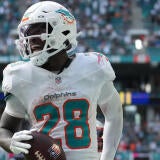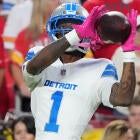Dynasty Fantasy Football Mailbag: Rebuilding strategy, valuing Packers running backs and more
Answering your Dynasty Fantasy Football questions

Early March is a bit of a dead period for Fantasy Football, but not for long. Soon enough we'll have franchise tags to discuss, the legal tampering period, NFL free agency, and the NFL Draft. In other words, the script is set for the next eight weeks of Dynasty mailbags. So this week, I'm going to tackle some of your generic offseason roster management questions, give you my recipe for a rebuild, and tackle a few of your player evaluation questions.
Managing offseason rosters
When do you recommend doing drops? Do your leagues typically drop players prior to the rookie draft? We have a 30 max with a 5 round rookie draft. Our platform allows keeping all players through the rookie draft, then dropping down to legal roster before the season.
— Patfan82 (@Patfan1982) March 1, 2022
This is more of a commissioner's question, but we also had a reader email question that came in asking about "who" to drop when it came time to cut players for rookie drafts. So I'll answer both.
First, for commissioners I strongly suggest requiring Fantasy managers to cut players before the first chance they have to add players. For example, in one of my leagues we have a free agent salary cap draft in March. In that league, you must have a legal roster to participate in that auction.
In another league, we don't have any free agency until after our rookie draft. But before the rookie draft, managers must clear enough roster spots to make their draft picks. This also involved moving everyone out of practice squad and IR slots from the prior season.
As for "who" you should cut, in many cases that's obvious. If it's not, then you may want to pursue trade options first. Don't drop someone if you could trade them and move up even one or two spots in the draft. After you've exhausted all potential trade options, I'm dropping backup wide receivers and tight ends first. Why? Because as we've seen in the past, it's much easier for a backup running back to leap into your starting lineup based on one injury. In one-QB leagues I would also drop backup QBs without much hesitation, especially if I have more than two.
Rebuilding strategy
What is your strategy when you need to rebuild?
— John Maas (@whodeyirish09) March 1, 2022
I love this question, because I love rebuilding. As I've said many times, I either want to be one of the four best teams in the league or one of the four worst. If I find myself in the middle, I'm immediately making trades to be one or the other, depending on the construct of my roster.
The first step of rebuilding is turning veterans into youth and/or draft picks. There is a bit of an art here, because I'm still trying to sell high if I can. In other words, I'd be more likely as a rebuilder to trade Cooper Kupp today than DeAndre Hopkins (more on that below).
If I'm truly rebuilding, I don't want any running back over 24 years old on my roster and I'd like to get rid of all receivers or tight ends 28 or older. As I stated above, that doesn't mean I'm giving them away in the offseason. I might hold guys like Hopkins, Ezekiel Elliott, and George Kittle because their perceived value isn't very high. It's quite possible a good game or two in-season (or an injury to one of the contenders) could cause a temporary spike in value. At the same time, you're risking a major injury that could drop their value to almost zero.
Here are five more rules I try to incorporate when rebuilding:
1. Start with wide receivers and quarterbacks, finish with running backs. You should not acquire starting running backs until you're ready to compete.
2. Stockpile running back handcuffs in-season. One injury could turn them into more draft picks for you next year.
3. Always try to get one more late draft pick thrown in when negotiating. That pick is probably not valued very high but could turn into an Elijah Mitchell or Pat Freiermuth.
4. Diversify the draft picks you acquire. You don't want to get stuck with 10 picks in 2022 when everyone decides 2022 isn't that great of a class.
5. Target contenders who suffer injuries. Players like JuJu Smith-Schuster or Michael Thomas can be acquired at a big discount after early in-season injuries.
Selling DeAndre Hopkins
Why won’t people trade for Hopkins?
— mitch (@mitchytommy05) March 1, 2022
So Mitch is experiencing something I was talking about earlier; it's hard to trade aging players who are currently hurt or coming off bad performances. People who don't have them on their team may just be scared they're trading for a has-been.
I don't necessarily believe that with Hopkins, but the closest values I have to him by position on my new trade chart are Hunter Renfrow, Dak Prescott, A.J. Dillon, and T.J. Hockenson ... or an early 2022 Round 2 pick. That's not near what you might be able to get for Hopkins if he's himself at the start of the 2022 season.
One other note: it pays to take your league mates' needs into consideration here. Realistically, only four to six teams in your league should have any interest in Hopkins at all. Don't be frustrated if the bad teams in your league won't make a reasonable offer for him; they shouldn't.
Valuing Packers' running backs
Aaron Jones or AJ Dillon?
— Jonathan Phillips (@swordofJAMocles) March 1, 2022
Like most, this trade question is easier if you tell me where your team is. Because I'd rather have Aaron Jones on a true contender; he projects for 74 more Fantasy points in my way-too-early projections and as a true contender that is what matters most to me. As a rebuilder, I'd rather have the younger back in A.J. Dillon.
In a vacuum, which is what the Dynasty Trade Chart tries to produce, I prefer Jones, but not by much. In terms of draft capital, they're separated by a late-2022 second round pick.
My expectation is that Jones will be better in 2022 and I think 2023 probably favors Dillon, but it's a bit of a coin flip. Dillon should be better after that, but who is actually playing for 2024 at this point? Only true rebuilders, and they'd probably be better off turning Dillon into draft picks and/or wide receivers.
Valuing Elijah Mitchell
Thoughts on Eli Mitchell
— Johnny Gutierrez (@JGThr33) March 1, 2022
I may have answered this one before, but Mitchell is one of the most difficult players to value, so it's worth rehashing.
The former sixth-round pick was the biggest riser in my Dynasty running back rankings over the past six months. Way back in September, Mitchell came in at RB72, behind teammates Raheem Mostert and Trey Sermon. But Mostert got hurt and Mitchell just flat-out won the job from Sermon. Mitchel now ranks at RB18 in the most recent update of those rankings and RB4 in his class, behind Najee Harris, Javonte Williams, and Michael Carter.
If this feels a bit like deja vu it's because we just did this with James Robinson a year ago. He was undrafted and had a better rookie year than Mitchell, but it's still an easy comparison. The upside is that they have already produced like top-12 backs in their first year in the league. The downside is that their team has very little invested in them.
We saw that downside manifest itself in 2021 for Robinson when Jacksonville used a first round pick on Travis Etienne. Even when Etienne was lost for the year, the team made Robinson share with Carlos Hyde early in the year. Robinson was finally unleashed late in the season but then he tore his Achilles and is a major question mark for 2022.
Mitchell has the benefit of stability. Kyle Shanahan isn't going anywhere and it's really hard to imagine the 49ers investing in a running back. But, as we've seen with Dante Pettis and Brandon Aiyuk, a good rookie season does not preclude one from beginning the next season in Shanahan's dog house.
Mitchell's lack of draft capital and the 49ers' recent history of running back usage has Mitchell ranked lower than he should be. I'm treating him as a mid-range RB2 for Dynasty purposes, with top-12 upside this year but very little guaranteed beyond that. And I wouldn't blame anyone for cashing in their chips and trading him based on the huge profit they made during his rookie season.

















